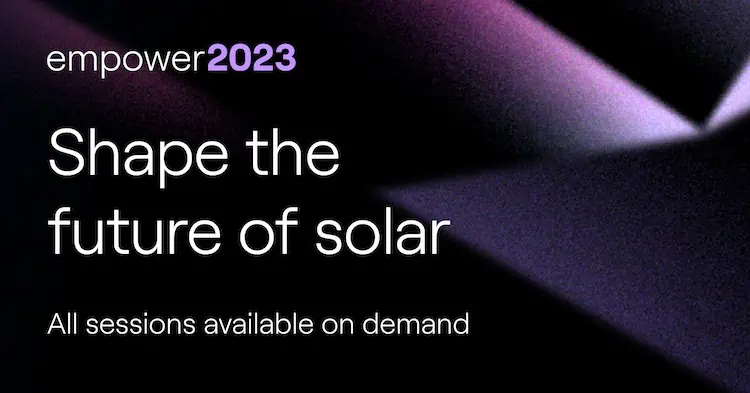The US residential solar + storage market continues its upward trajectory, with the Solar Energy Industries Association (SEIA) predicting that by 2025, one in every three new solar PV systems will be paired with storage. Driving this growth are factors like increasing power outages, net metering policies, financial incentives, and virtual power plants (VPPs).
As this demand continues to grow, photovoltaic (PV) installers are in a great position to benefit by expanding their product offerings. Our Empower 2023 session — Powering the Future: Unlocking Business Growth through Solar Storage — explored this opportunity and how installers can take advantage.

The session investigated growth opportunities, challenges ahead, and the importance of customer education for storage sales. Let’s look at some of the drivers for growth, as well as how to manage the transition to battery storage.
What’s driving solar-plus-storage growth?
There are a few things the panel mentioned when discussing the solar + storage opportunity.
Increasing grid reliability issues and outages
Grid reliability and outages are driving many customers to seek backup power solutions as an insurance policy against blackouts. Weather-related disruptions like storms, heatwaves, and wildfires are becoming more frequent across the country, leading to more power failures. Attachment rates for solar + storage often spike following these major outage events, as utility consumers seek protection.
Revenue opportunities from battery storage
New revenue opportunities through virtual power plant (VPP) and grid services programs are also incentivizing customers to install storage. These programs pay solar households to let utilities access their stored battery capacity to help balance supply and demand. Essentially, utilities are willing to pay for the right to tap into these distributed virtual power plants remotely and on demand.
Battery storage incentives
Financial incentives like California’s Self-Generation Incentive Program (SGIP) are making storage systems more affordable. SGIP provides upfront rebates for adding storage to solar. The program increased rebates to $150 per kWh recently for low-income households, directly incentivizing more storage add-ons.
Changes in net metering
Changes to net metering policies — seen in California with NEM 3 — are encouraging greater self-consumption of solar and making batteries more financially attractive. Customers can store excess daytime solar production to use in the evening when rates are higher. With solar incentives shifting in many markets, adding storage solutions provide long-term ROI.
To see how Aurora can help solve the challenges of selling storage — including our new hourly visualizations — click through this quick tour.
Bright future for battery storage
While policy shifts like net metering 3.0 in California have created some short-term headwinds, the veteran solar executives on the webinar panel emphasized that the long-term tailwinds are strong. The outlook for solar paired with storage remains positive over the next 5-10 years.
Despite this continued growth, PV installers still face challenges scaling up their storage capabilities. Steep learning curves, evolving best practices, and new complexities can make growing storage sales difficult.
Managing the transition to battery storage for solar systems
While the fundamentals of sizing panels and inverters carry over from their solar-only experience, the increased complexity of integrated systems can trip up those unprepared for the intricacies. Configuration challenges, policy shifts, and general project intricacies can all prove daunting.

Below are some of the biggest obstacles PV installers face when integrating storage solutions into their core offerings:
- Optimally configuring a solar + storage system introduces challenges, as more components must work together seamlessly. Default battery and inverter pairings often don’t maximize savings potential. Detailed modeling is essential but adds time and complexity compared to solar-only projects. Leveraging software tools can help streamline otherwise complex storage configurations with smart recommendations for compatible components and sizes.
- Staying current on the evolving incentive landscape also grows tougher with solar batteries in the mix. Policy changes around net metering, demand charges, time-of-use rates, and more all impact the value proposition. Dedicated staff must track federal, state, and utility developments to maximize revenue and savings. For example, some utilities offer rebates for solar plus storage — but not separately. Keeping abreast of the latest programs and rate structures takes focus.
- The projects themselves also increase in intricacy. Crews adept at rooftop solar installations often lack experience with residential battery wiring and electrical panel work. Specialized storage install teams are ideal, as running conduits and managing upgraded panels differs greatly. Likewise, securing permits and inspections requires nuanced expertise, as authority having jurisdictions (AHJs) are still adapting to evolving protocols around home batteries. Having skilled office staff that understand logistics and local requirements saves major headaches in the field.
- While installers must level up their knowledge, buyers also face education gaps on actual system capabilities. Ensuring customers have proper expectations is crucial, as overpromising leads to disappointment and negative reviews. Providing transparent consultations with backup power and duration options prevents unwelcome surprises down the road. Following up post-installation to address concerns and gather feedback further optimizes the customer experience.
Though scaling storage capabilities brings challenges, the key lies in educating both staff and customers. Leveraging the right tools to simplify complex configurations, pricing, and proposals also pays dividends. With preparation and dedication, PV installers can overcome the pitfalls as solar plus storage continues to gain in popularity.
In closing…
Watch the entire session on demand to get insights into even more potential opportunities and pitfalls facing PV installers:
- Choosing reliable, proven storage products from reputable battery manufacturers
- Managing inspections and jurisdictional requirements – even as they evolve
- Setting proper customer expectations around battery storage capabilities
- Avoiding overpromising storage performance and battery capacity
Have more questions? Schedule a quick, personalized demo to learn more.


